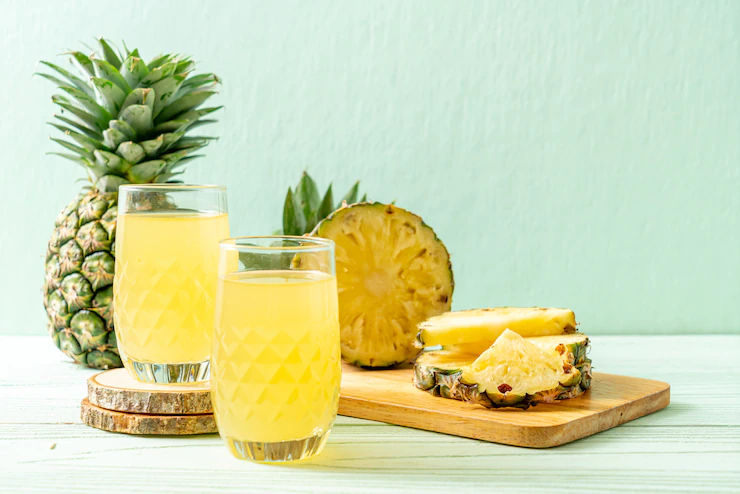Drinking a cup of pineapple juice every day has various health benefits, including improving digestive health and increasing your immune system. Bromelain, vitamins A and C, and various minerals can all be found in pineapple. Pineapple juice has a lot of vitamins and minerals in it. It’s incredibly high in manganese, copper, vitamin B6, and vitamin C, all of which are essential for your body’s normal functioning. Bromelain and vitamin C are found in pineapples, and they may help alleviate asthma symptoms.
Bromelain, a set of enzymes found in pineapple juice, may reduce inflammation caused by trauma, injuries, surgery, rheumatoid arthritis, or osteoarthritis. However, further juice-specific research is required. Pineapple juice has been linked to a better immune system in several studies.
It may also aid in the improvement of antibiotic efficacy. However, further research is required before firm conclusions may be drawn. Bromelain, found in pineapple juice, may help with digestion, protect against harmful bacteria that cause diarrhea, and reduce inflammation in those who have inflammatory bowel disease. More research, however, is required. Pineapple juice is a refreshing and healthful beverage, and it contains Bromelain, an enzyme that assists digestion, making it an excellent way to round off a meal.
Vitamin C is also abundant in pineapple juice. Pineapple juice is simple to make, although peeling and cutting the pineapple can be challenging at times. Enjoy fresh pineapple juice made at home, free of artificial additives and preservatives. In several studies, Bromelain, which is naturally contained in pineapple juice, has been linked to indications of improved heart health. However, more research on pineapple juice is required.
How To Make Pineapple Juice?
Remove the pineapple’s leafy top by slicing it off. Then, using a knife, carve a small triangular notch in the flesh’s edge to make a straw entrance. Step two: After you’ve cored the pineapple (as shown above), pour a cocktail inside. Reattach the pineapple’s top and secure it with a toothpick.
Place your pineapple on a cutting board. To peel a pineapple properly, you’ll need an extremely sharp chef’s knife. Turn it over on its side. One-fourth inch (0.6cm) underneath the leaves, place your knife. Slice until the leaves are reached. Turn the pineapple and continue until the top and many leaves have been sliced away in a circle. Remove them from the center leaves by lifting them and discarding them.
You can chop the pineapple while holding it steady with the remaining central leaves. Some chefs recommend removing the entire top. You can do this as well, but be careful not to let your hand slide off the pineapple’s top. When you cut the pineapple, a lot of slick juice comes out.
What Are The Benefits Of Drinking Pineapple Juice?
- Nutrient-dense: Pineapple is high in nutrients that help bone health, immunity, wound healing, and energy creation.
- Anti-inflammatory: Pineapple juice contains an enzyme called Bromelain, which can help reduce pain and swelling linked with sports injuries and osteoarthritis.
- Digestive health: Pineapple juice contains enzymes that might aid with constipation and bloating. Bromelain’s antibacterial qualities can protect your intestines from the bacteria that cause diarrhea, Escherichia coli.
- Drinking pineapple juice regularly may help ease cold and allergy symptoms due to its bromelain concentration and anti-inflammatory properties.
- Bromelain has been shown in certain studies to assist dissolve blood clots in the heart’s arteries, lowering the risk of cardiovascular diseases and heart attacks.
- High amounts of antioxidants—vitamins A and C, as well as beta-carotene—can protect your eyes by preventing cataracts and visual impairments associated with aging.
- High amounts of vitamin C and beta-carotene can help enhance overall skin texture while protecting it from age-related changes and the destructive effects of UV radiation and pollution.
Ways To Use Pineapple Peel
We’ve heard about pineapple tepache tonic’s refreshing, probiotic-rich advantages, as well as the bowl-of-sunshine quality of this vegan summer corn soup. Let’s look at some new ways to use pineapple peels to make your body and the environment happy:
Pineapple Agua
As simple as it seems, Pineapple water is a powerful and straightforward way to gain the benefits of pineapple peels. Place the outer skins (not the fruit) in a medium saucepan with 2 to 3 cinnamon sticks (optional) and let it simmer for 25 to 35 minutes on low heat. Remove the pan from the heat and steep the mixture for 30 minutes before straining out the peels.
This citrus-infused agua can be served hot or cold and sweetened to taste. This pineapple peel agua is also a tremendous water-based flavoring replacement that you should keep on hand.
Pineapple Peel Tea Ritual
A pineapple peel tea ritual (or any other intentionally constructed ritual) provides a unique and intimate opportunity to become attentive to ourselves from the inside out. Drink your tea carefully and reverently, as if it were the axis around which the Earth revolves as if it were the axis around which the Earth rotates. The health advantages acquired from adopting a tea ritual extend beyond the cup.
Because inflammation and stress are at the root of most modern diseases, brewing and drinking tea may be an intelligent way to help us slow down. According to one study, participants who drank black tea four times a day for six days a week had lower cortisol (stress hormone) levels than those who drank a placebo. If you add a pineapple peel to your ritual, you’ll have a delicious anti-inflammatory treat.
Pineapple Salad
If you’re in the mood for adding a tropical lift to your next meal, why not try eating out of a fresh pineapple bowl? Blend the fruit’s delightful juice with a healthy and nutritious filling, and enjoy! (You can even fill the pineapple bowl with your favorite smoothie recipe, add a straw, and drink up.)
Prepare A Tasty, Antioxidant-Rich Juice (Or Cocktail)
When making any drink healthy (and a little tangier), pineapple peel can be a great addition. To use pineapple peel agua as your next juice base, boil the skins first and cool them down ultimately (see directions above). Next, strain the water, put it in a blender, and add any additional juice ingredients of your choice.
Is It True That Pineapples Are Poisonous?
The skin of the pineapple plant is not poisonous, and while the entire fruit is not poisonous, the unripe flesh, thorns, and leaves can be harmful. This is due to the enzyme bromelain, which is used to tenderize the meat and is highly safe. Humans are poisoned by unripe pineapple, which can cause severe diarrhea and vomiting. It’s best not to consume too much pineapple core because it can cause fiber balls to grow in your intestine.
Unripe pineapple is toxic to humans and can cause severe diarrhea and vomiting if consumed in large quantities. Consuming an excessive amount of the pineapple core may form fiber balls in the digestive tract, which should be avoided. Even though the skin of the pineapple plant is not hazardous, and while the entire fruit is deemed non-toxic, the unripe flesh, thorns, and leaves of the pineapple plant can be toxic when consumed due to the enzyme bromelain, which is commonly used as a meat tenderizer and is believed to be of low toxicity.
How To Pick The Right Pineapple?
Your pineapple will be sour if it isn’t fully ripe, and it may be far too sweet if it is overripe. The most critical step in preparing great pineapple juice is selecting the correct pineapple. It will be sour if the pineapple is not fully ripe, and it could be considered too sweet if it is overripe. The most critical step in preparing great pineapple juice is selecting the appropriate pineapple.
Take a look at the hue of the pineapple. A green pineapple is not always immature because it has a golden-yellow tint. Keep in mind that pineapples are ripe even though they are still green. More attention should be placed on the pineapple’s healthy appearance. All be avoided by wrinkled skin, reddish-brown skin, fissures or leaks, mold, or withering brown leaves.
When you press down on the pineapple, you want it to be firm but soft enough to give slightly. While frozen or canned pineapple can be used, fresh pineapple juice usually tastes better.
What Are The Side Effects Of Pineapple?
Anticoagulants, blood thinners, anticonvulsants, barbiturates, benzodiazepines, insomnia medications, and tricyclic antidepressants should avoid overeating pineapple. Because pineapples are a fantastic meat tenderizer, overeating them might cause oral softness. Because of its high vitamin C concentration, eating too many pineapples can produce various symptoms such as nausea, diarrhea, vomiting, abdominal pain, and heartburn.
For most healthy people, drinking pineapple juice is probably harmless. However, in some situations, it may result in the following adverse effects:
Allergies
Pineapple juice can cause allergic reactions in some people, such as a rash or difficulty breathing. If you get any allergy symptoms, such as hives, stop drinking them.
If you have acid reflux, you should avoid pineapple juice since it contains high quantities of vitamin C, which can irritate the stomach and induce nausea and discomfort. Excessive pineapple juice consumption might also cause diarrhea.
Weight Gain
Because pineapple contains a lot of natural sugar, drinking too much of it might gain weight.
Toxic Effects
Unripe pineapple juice can cause toxicity in the intestines, resulting in symptoms including vomiting and diarrhea. Make sure the juice is made from fully ripe pineapples. Pregnant women are frequently advised to avoid pineapples since they have been shown to produce uterine contractions in lab trials, although current medicine practitioners see this as a myth.
Conclusion
Pineapple juice is high in vitamins, minerals, and valuable plant chemicals that may help you stay healthy. This beverage has enhanced digestion, heart health, and immunity in studies. Pineapple juice or its constituents may also aid in the reduction of inflammation and may even provide some protection against some cancers. However, human research is limited, and it’s uncertain whether the effects seen in test tubes or animals can be replicated by consuming small amounts of pineapple juice daily. Furthermore, because this beverage is low in fiber and high in sugar, consuming significant amounts every day is not suggested.

